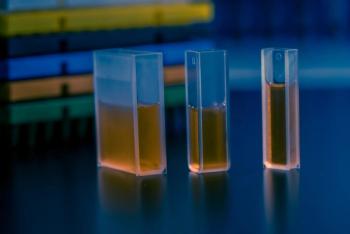
- Pharmaceutical Technology-01-02-2015
- Volume 39
- Issue 1
How Accurate are Your Dilutions?
The choice of dilution schemes can minimize solution preparation errors.
Most analytical procedures rely on the accurate preparation of reference standard solutions. It is common practice to prepare such solutions volumetrically using standard glassware. Usually a stock solution is prepared followed by a dilution or series of dilutions to arrive at a working concentration of the reference standard. This column looks at the effects of choice of dilution schemes on the accuracy of the prepared reference standard.
A previous column looked at the basics of measurement uncertainty and related it to the direct preparation of a standard solution were discussed (1). This column will review the preparation of standard solutions by simple and serial dilution using standard pipettes and flasks. Only the uncertainties in the volumetric glassware, however, will be considered to answer the question: “Is my dilution accurate enough?” It will be assumed that all the other factors (e.g., operator variability when pipetting or making up to the mark, temperature, and solvent effects) are constant.
Further, it will be assumed that standard Grade A glassware are being used (2). Accuracy in the context of this column is the International Organization for Standardization (ISO) definition. In ISO, accuracy combines the concepts of unbiasedness (termed trueness) and precision (3).
Suppose an analytical procedure states that a standard solution of 1 mg per liter is required by dilution of a 50 mg/L stock solution. The question arises “What is the ‘best way’ to perform this dilution volumetrically?” The ‘best way’ would be to have minimal dilution error (i.e., smallest measurement uncertainty commensurate with the analytical need). This column will only consider some whole number dilutions, but the principles apply to any dilution or dilution sequence.
Tolerances in Grade A volumetric glassware
For volumetric glassware, tolerances are an ISO Type B uncertainty and are converted to a standard deviation,
ux, assuming a triangular distribution, as it is more likely that the value lies closer to the central value (3). For a range of ±a, the corresponding estimate for the standard uncertainty would be
and the % relative uncertainty ux/x. These calculations are shown in Table I.
Choosing the best combinations Grade A volumetric glassware
Relatively little has been published on the optimum choice of pipettes and flasks (4, 5). Indeed, there appears to be little awareness in laboratories that the selection of different combinations results in different accuracies. At least one textbook covers the practicalities of volumetric operations (6). Lam and Isenhour in 1980 (4) covered minimization of volumetric errors using error propagation theory but only considered combinations of 4-, 10-, 15-, 20-, and 25-mL pipettes and flasks from 25 to 1000 mL (4) with relative errors of 0.13 to 0.35% for one step to three step dilutions. In this paper, the tolerance interval a was selected for ux. This was not correct in that
. The results in their table need to be divided by 2.45 to be corrected for this issue. They defined a concentration ratio, C, for any pipette (Pi)/flask (Fi )dilution sequence of n steps (Equation 1).
Note that the summation term,
is multiplicative not additive.
Hence, for a sequence 20 to 1000 followed by 25 to 500, C would be 1/1000 or a dilution of 1000:1.
Consider the number of combinations of standard glassware to make a single dilution. Assume that in the laboratory, there are pipettes from 1 mL to 25 mL and volumetric flasks from 5 mL to 1000 mL. Table II illustrates single step whole number dilution ratios from 5 to 1000. The dilution ratio here is 1/C of Equation 2.
Based on error propagation theory (7), the combination of relative errors for any pipette (Pi)/flask (Fi)dilution combination sequence of n steps can be calculated from Equation 3 and the results are shown in Table III.
In this example of preparing a 1 mg per liter dilution from a 50 mg/L stock solution in a single step, five combinations can be selected from Table II; 1 to 50, 2 to 100, 5 to 250, 10 to 500, and 20 to 1000. Do they all have the same accuracy? To answer this question, look up the appropriate combined relative uncertainties in Table II.
For all the combinations in Table II, Table III gives the combined uncertainties as a %.
From Table III, the bigger the pipette and the bigger the flask is, the lower the combined relative standard uncertainty. Larger amounts of both solvent and solute, however, are needed to achieve a factor of 5 gain from a single dilution.
Returning to the 50-fold dilution, this effect is illustrated (Table IV) as the 20 to 1000 dilution produces a lower uncertainty by a factor of four compared with the 1 to 50 dilution. This comes at a cost of solvent and solute. So what is ‘best for you’? The 1 to 50 dilution may be perfectly acceptable.
Suppose, however, the laboratory wanted to achieve this 1:50 dilution with minimum solvent and solute usage by preparing a stock solution in a 10-mL flask and serially diluting it 1 to 5 and then 1 to 10. The resulting standard uncertainty from volumetric sources would be seen in Equation 4.
The numerical values are taken from the ux/x values in Tables I and III. Note that this value is slightly different from the value in Table IV. This is because there is a small contribution from the original 10-mL flask.
Ignoring the uncertainty contribution associated with weighing 0.5 mg of a reference standard, the volumetric uncertainty due to the serial dilution is 0.40%, which is 1.6 times larger than a simple 1 to 50 dilution. Bearing in mind that at a coverage factor, k, of 2 (95.45% Confidence), the volumetric uncertainty alone would approach 1%. In this instance, a complete error budget calculation would probably show that the overall uncertainty at a coverage factor of 2 might be too large from this sequence to be employed in practice for an assay standard.
Quite often a 1000-fold dilution is needed. Table V shows three examples. In the first one, it is a simple one-step 1 to 1000 dilution resulting in a reasonably accurate result. However, it requires a lot of solvent. A three-stage serial dilution process is attractive to reduce solvent usage. The smallest serial dilution process is three 1.00 to 10.0 dilution steps. This dilution sequence results in about twice the measurement uncertainty. However, three 5.00 to 50.0 dilution steps or three 10.00 to 100.0 dilution steps could also be used to achieve the same dilution. The three 5.00 to 50.0 dilution steps shows not only an improvement of about half the measurement uncertainty of the 1000-fold dilution, it also saves approximately 75% of the solvent. There is no advantage in using three 10.00 to 100.0 dilution steps over three 5.00 to 50.0 dilution and it uses twice as much solvent.
Conclusion
As analytical procedures rely on the accurate preparation of reference standard solutions, it is important to know what the probable effect of analytical operations will be on the overall measurement uncertainty of the analytical result. Whereas volumetric dilution errors are small, they are not insignificant. The structure of dilution sequences can play a significant role in contributing to an uncertainty budget. Examples in this column have demonstrated both the method of estimation and extent of uncertainty contributions.
References
1. C. Burgess, Pharm. Techn., 37(9) 62-64, 73 (2013).
2. ISO 648:2008 Laboratory glassware. Single-volume pipettes. ISO 1042:2000 Laboratory Glassware - One-mark volumetric flasks
3. S L R Ellison and A Williams (Eds).
4. R. B. Lam and T. L. Isenhour, Anal. Chem., 52(7), 1158 -1161 (1980).
5. Y Hayashi and R Matsuda, Analytical Sciences, 10(6) 881-888 (Japan Society for Analytical Chemistry, 1994).
6. D. A. Skoog, D.M. West, F J Holler, Fundamentals of Analytical Chemistry, 7th edition, 798-808 (Saunders College Publishing, 1996).
7. A.A. Clifford, Multivariate Error Analysis, Applied Science Publishers (Wiley, New York, 1973).
Article DetailsPharmaceutical Technology
Vol. 39, Issue 1
Pages: 62–64
Citation: When referring to this article, please cite as C. Burgess, “How Accurate are Your Dilutions?,” Pharmaceutical Technology39(1) 2015.
Articles in this issue
almost 11 years ago
Value-Based Healthcare in the: United Kingdomalmost 11 years ago
Mitigating Risk for Single-Use Assemblies in Sterile Fillingalmost 11 years ago
Building a Barrier in Solid-Dosage Drug Packagingalmost 11 years ago
Using Tocophersolan for Drug Deliveryalmost 11 years ago
Industry Expert Q&A with Fred Miesowiczalmost 11 years ago
Innovative Excipients in Solid-Dosage Manufacturingalmost 11 years ago
Great Expectations from New European Commissionalmost 11 years ago
Analyzing Protein Aggregation in Biopharmaceuticalsalmost 11 years ago
Ross Charging Hopper Increases Efficiencyalmost 11 years ago
Standards Organizations UpdateNewsletter
Get the essential updates shaping the future of pharma manufacturing and compliance—subscribe today to Pharmaceutical Technology and never miss a breakthrough.



